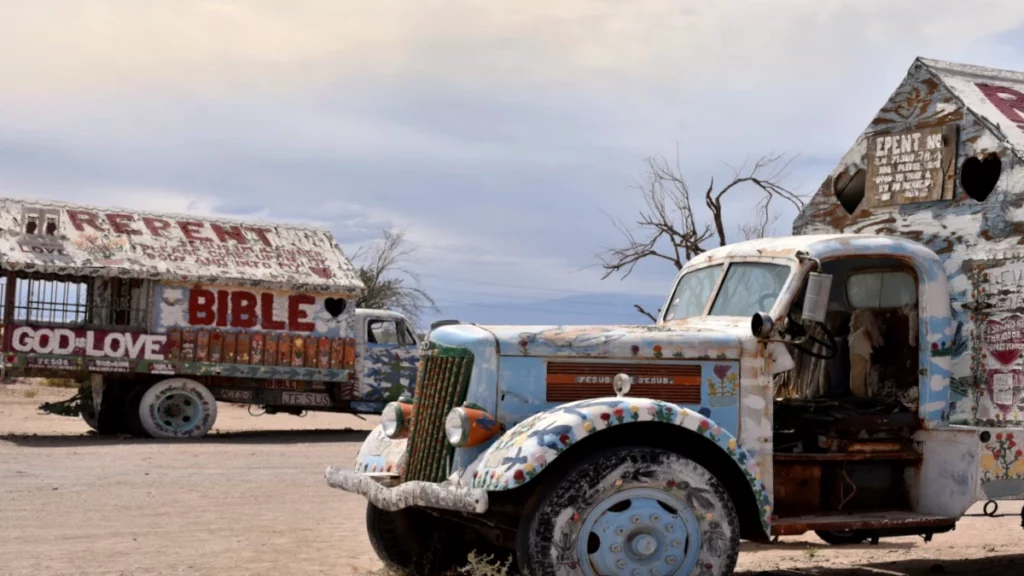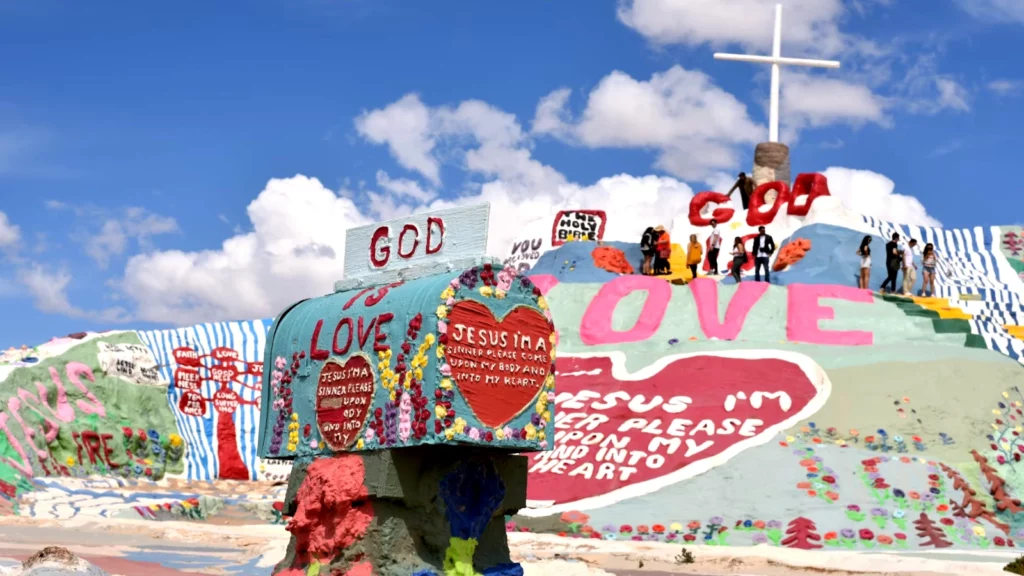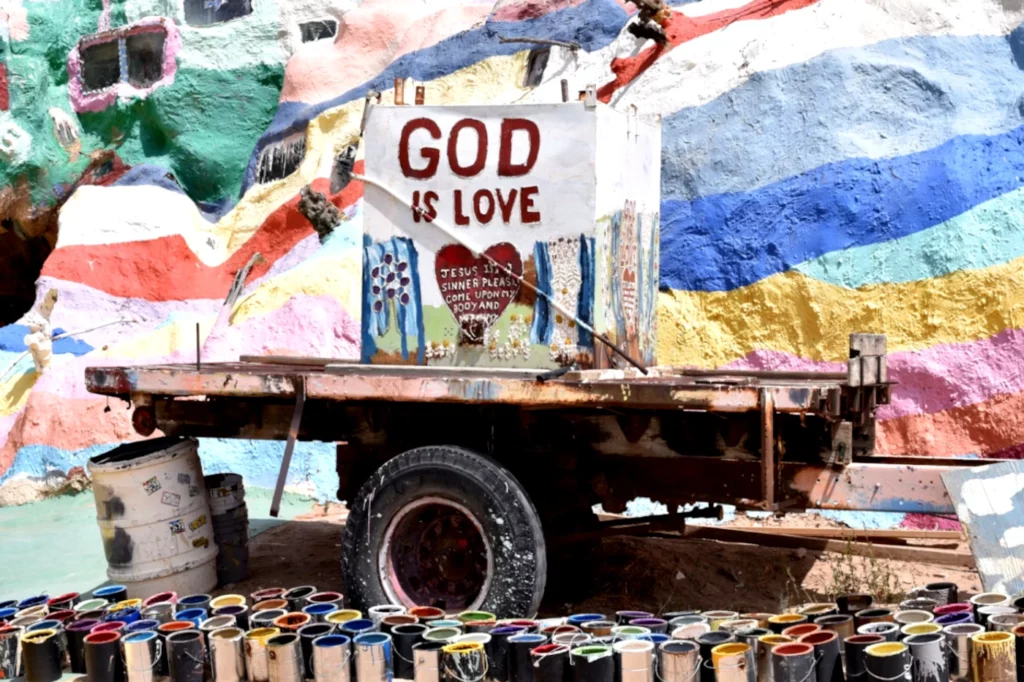Slab City, California, stands as a unique example of a community that operates outside the traditional legal framework.
While it may not be entirely lawless, its residents have created a space where they can live according to their own rules.
Slab City, often referred to as “the last lawless city” in America, is an unincorporated community located in the California desert, specifically in Imperial County.
This unique settlement has become a refuge for those seeking an alternative lifestyle, free from the constraints of mainstream society.
But as the community faces increasing scrutiny regarding its safety, crime rates, and governance, the future of Slab City and of its reputation as a place of freedom – in the anarchist sense – are nothing but a question mark.

A Brief History of Slab City
Slab City gets its name from the concrete slabs that remained after the U.S. Marine Corps Camp Dunlap was decommissioned following World War II.
Over the decades, the area has attracted a variety of residents, including artists, retirees, and those experiencing homelessness.
Many residents, affectionately known as “Slabbers,” have chosen this life to escape societal norms and find a sense of community among like-minded individuals.
The settlement covers roughly 640 acres of public land near the Salton Sea, about 100 miles northeast of San Diego. It is situated in one of the hottest regions in California, where summer temperatures can soar above 120 degrees Fahrenheit.
Despite these harsh conditions, Slab City remains a vibrant community, with a unique culture that includes art, music, and a strong sense of camaraderie.
Current Population and Demographics
Slab City has a small year-round population of about 150 residents, but the community is much larger than that.
During the winter months, this number can swell to approximately 4,000 as seasonal visitors, often referred to as “snowbirds,” flock to the area to escape colder climates.
These visitors include RVers, van-lifers, and other nomadic individuals looking for a place to stay.
The influx of people during the winter months brings a mix of energy and challenges to the community, as residents navigate the complexities of increased tourism while maintaining their way of life.

Crime Rates and Safety Concerns
Slab City has gained a reputation for being a lawless place, and while it does operate outside the traditional legal framework, it is not entirely devoid of law enforcement.
The Imperial County Sheriff’s Office patrols the area, responding to various incidents, although their presence is often limited.
Crime in Slab City tends to revolve around issues like drug use, particularly methamphetamine, which is prevalent in the community.
While specific crime statistics for Slab City are not readily available, reports indicate that theft, disputes over camping boundaries, and drug-related incidents are common.
The community has its own informal systems for resolving conflicts, with many residents preferring to handle disputes internally rather than involving law enforcement.
This approach reflects the libertarian ethos of Slab City, where many residents value their independence and self-governance.
Safety, particularly at night, is a significant concern for both residents and visitors.
While many Slabbers feel secure within their community, the absence of formal law enforcement can lead to unpredictable situations.
Visitors are often advised to exercise caution, especially after dark, as the lack of streetlights and the presence of individuals under the influence of drugs can create potentially dangerous scenarios.
Despite these risks, many long-term residents describe Slab City as a generally safe place, emphasizing the strong bonds formed within the community.
The Impact of Climate Change
Climate change poses a significant threat to Slab City and its residents. The area is already one of the hottest in California, and rising temperatures are expected to exacerbate these conditions.
Extreme heat can be dangerous, especially for vulnerable populations, and residents must find ways to cope with the harsh climate.
Many Slabbers have developed strategies to stay cool, such as using shade structures and staying indoors during the hottest parts of the day.
The community’s reliance on solar power and generators for electricity is also a response to the challenges posed by climate change.
With no running water or sewage systems, residents must be resourceful in managing their basic needs.
Clean water is often obtained from a tank at the community church, and residents work together to address the challenges of living off the grid.

Who Owns Slab City?
The ownership of the land on which Slab City resides has been a topic of debate for years.
It is generally believed that the land is owned by the State of California, but there have been discussions about its potential sale.
In recent years, the California Lands Commission has considered appraising the land, which has raised concerns among residents about their future.
Many fear that a sale could lead to commercial development or displacement, threatening the unique lifestyle that Slab City offers.
In response to these concerns, some residents have organized to form the Slab City Community Group.
This group aims to protect the community from potential sales and to explore the possibility of establishing a land trust. The idea is to secure the land for future generations and maintain the spirit of independence that defines Slab City.
Community Life and Culture
Life in Slab City is characterized by a strong sense of community and creativity. Residents often come together for events, such as the annual prom night, which serves as a celebration of their unique culture.
This event, held at The Range, an open-air music venue, allows residents of all ages to dress up, dance, and enjoy each other’s company.
It is a testament to the resilience and spirit of the Slabbers, who find joy in their unconventional lifestyle.
Art is also a significant aspect of life in Slab City. The community is home to several artistic projects, including Salvation Mountain, a large, colorful structure created by artist Leonard Knight. This iconic landmark attracts many visitors and serves as a symbol of hope and creativity in the desert.
Another notable project is East Jesus, an experimental art installation that showcases the work of various artists and encourages creative expression.
Despite the challenges they face, residents of Slab City find solace in their shared experiences and the connections they build with one another.
Many Slabbers have faced hardships in their lives, such as homelessness, addiction, or mental health struggles. For them, Slab City represents a chance to start anew and find a sense of belonging.
The Future of Slab City
As discussions about land ownership and potential development continue, the future of Slab City remains uncertain. Residents are divided on how to approach the possibility of a sale, with some advocating for preservation and others open to change.
The community’s unique lifestyle and culture are at stake, and many residents are determined to protect their way of life.
The ongoing challenges posed by climate change, crime, and governance will continue to shape the future of Slab City.
As the community navigates these issues, the question of whether it remains above the law will evolve.
Read more: Slab City, the Last Free Place in America

Your n°1 source of information on the world of sandsports and desert adventure travel. Our articles are the result of extensive research, personal experience, and knowledge-sharing within the global sandboarding community.